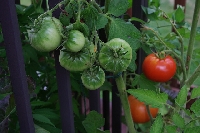Can you grow vegetables in pots
By Catalogs Editorial Staff

It’s easy to grow vegetables in pots with a little creativity and some skill
There is a big push lately for people in urban areas to grow their own food. Backyard gardens and community gardens are cropping up right and left, and why not? When you grow your own produce, you save money. You eat healthier, since you are more apt to eat veggies you nurtured yourself. You have total control over how your food is grown. And you lessen your carbon footprint by eradicating the food miles your produce must travel to get to your plate.
But, what if you don’t have a yard? What if all you have is, say, a fire escape or a patio to work with? What if your only option is to grow your food in pots?
Yes Virginia, You Can Grow Carrots in Pots
You will be pleased to learn that urban gardeners everywhere are overcoming this very same problem. And the answer, of course, is yes, absolutely. You can grow vegetables in just about anything.
Assess Your Space
When planning a container vegetable garden, the very first thing to determine is how much space you have to work with. Go out to your little porch or fire escape or apartment building rooftop (if you live in one of those cool places where your apartment manager will let you use that space) and look around.
~
Measure and evaluate the space available to you, and don’t forget to consider your vertical space. Vertical space is gold in tight situations. You can grow climbing plants on trellises, and hang small containers from balcony railings.
Get creative. Look up some ideas online. There is a wealth of urban farming information out there.
Pick Your Favorite Veggies
Next is the fun part. Make a list of what you want to grow. If you are new to vegetable gardening, keep it simple. Choose vegetables that you know you like, are known to thrive in your region, and aren’t complicated to grow.
Then, find out how much space your wish-list veggies require. Broccoli is a wonderful, nutritious vegetable, great for cooler climes, but it requires a fair bit of space. Yes, you can grow it in containers. But if you’ve only got a 5’x6′ balcony to work with, you might forgo broccoli in favor of something which requires a little less elbow room.
Some good options for small space container gardens are lettuces, spinach, carrots, and onions. They take relatively little room, and can be started early in the growing season. Also, look for ?container? varieties of your favorite fruits and veggies.
Strawberries are a classic addition to a container garden. (They even make special pots for them!) And there are several types of tomatoes which have been cultivated to do well in containers, while other varieties might not give as high a yield in the cramped confines of a pot.
Choose Your Containers
Next, gather your containers and soil. Containers can be almost anything, from traditional store-bought pots, to 5-gallon food buckets (make sure, if you are using plastic, that the container didn’t house anything toxic in its former life, as these toxins may leach into your potting soil), to old boots, as long as they will hold dirt.
The soil you choose, on the other hand, must be potting soil–preferably organic, since you are going to be eating this stuff. Regular bagged garden soil doesn’t contain enough nutrients to sustain a potted plant. Remember, a pot is a closed system–your plants will never have any more nutrients than what you directly provide to them.
When you?re ready to plant your seeds, be strategic. You don’t want to cram a bunch of carrot seeds in too close to your lettuce just to have the carrot seedlings smothered by the fast-growing greens. On the other hand, you want to take advantage of every possible inch of soil you have.
For example, some herbs make good ?ground cover,? like growing thyme in the unused soil surrounding a tall tomato plant. Other things take up so little room that they are great for filling in spaces. Slim bunching onions, for example, fit beautifully around the perimeter of your spinach plants and other greens.
With a little work, some research, and a touch of creativity, you can grow food nearly anywhere.
Popular Savings Offers





.png)


.jpg)
.png)

